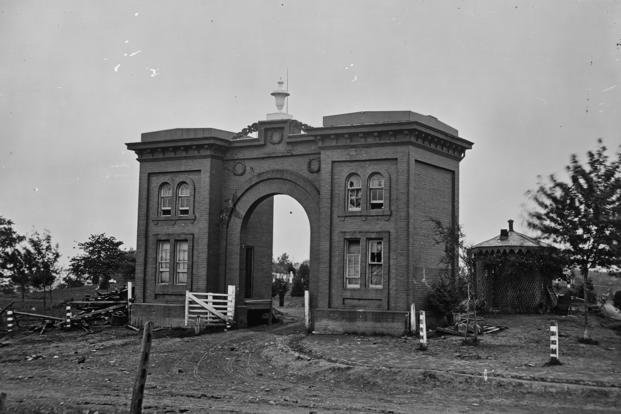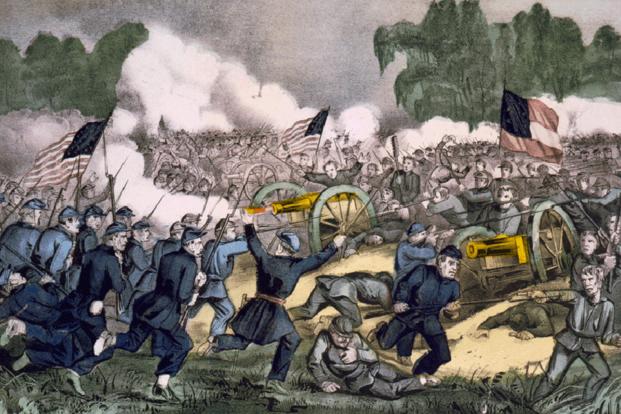For one week, Elizabeth Thorn, her three young sons and her parents abandoned their home during the Battle of Gettysburg in 1863. When they returned, Thorn not only discovered barely a belonging left at their residence at Evergreen Cemetery, but -- as the fill-in for her husband, Peter, who left his job as its caretaker to fight against the Confederacy -- she was responsible for digging graves for the Union's dead.
The stench of decomposing bodies was overpowering, the terrible smell made all the more repugnant by the stifling July heat. It was no job for a woman who was six months' pregnant, and yet, Thorn somehow met the moment.
"It was only excitement that helped me to do all the work," Thorn recalled in a first-person account posted by the website CivilWarTalk in 2014.

Born in 1832 in Germany, Elizabeth immigrated with her parents, John and Catherine Masser, to the United States when she was in her early 20s. When they arrived in New York, they realized their luggage had been stolen -- their anxiety assuaged only by the assistance of a helpful stranger.
Peter Thorn, who was heading to Pennsylvania, offered to help relocate the family there, and with no firm plans, they accepted. The chance encounter sparked a romance between Peter and Elizabeth, who were married in 1855, and early the next year, he accepted a position as the caretaker of a new civilian cemetery in Gettysburg, just above Pennsylvania's border with Maryland.
The Thorns lived with Elizabeth’s parents in the cemetery's gatehouse and were building a good life, growing their burgeoning family and establishing roots in the area. When the Civil War broke out at Fort Sumter, South Carolina, on April 12, 1861, Peter -- believing the skirmish would be resolved in short order -- did not immediately join the Union's military. Nearly a year and a half after the war's first shots, he finally joined the 138th Pennsylvania Infantry.
At home, raising three young boys and trying to match their seemingly endless energy, Elizabeth was also dealing with her changing body as she entered the third trimester of her current pregnancy. The war was undoubtedly of concern, but it had never approached her doorstep until Confederates stormed through town on June 26, 1863.
After the hungry southerners told Elizabeth they had no intention of harming her family, her mother heeded their request and fed them. The rebels left the next day -- but not before they destroyed bridges, railroads and telegraph lines. "Everywhere, they destroyed all they could," Thorn said in her recollections published on CivilWarTalk.com.

On July 1, the first day of the Battle of Gettysburg, the Confederates drove Union forces in the direction of Cemetery Hill, where Elizabeth's family lived. That night, Maj. Gen. Oliver Howard -- along with fellow corps commanders of the Army of the Potomac Maj. Gens. Daniel Sickles and Henry Slocum -- came to the residence, and before they left, he warned Elizabeth there would be intense fighting the next day and she and her family should "leave this house and get as far away in 10 minutes as possible. Take nothing up but the children and go."
The next day, the Thorns departed and rested that first night at a farmhouse surrounded by a group of Union soldiers. They soon relocated to another farm, where the family ate for the first time in 24 hours -- a welcome relief for all but especially for the expectant Elizabeth. The fighting at Gettysburg ended on July 3, leaving behind a level of carnage -- 3,155 Union soldiers and 3,903 Confederate troops dead, plus a combined 33,264 wounded -- unseen in any other Civil War engagement.
When Elizabeth returned to Evergreen Cemetery on July 7, her initial reaction upon seeing the gatehouse was, "O, my!" -- a somewhat muted response given what she discovered. The home was ransacked, nearly all furniture was gone, and shattered windows left shards of glass everywhere. The water pump was broken, and blood and dirt ruined beds on which soldiers' legs had been amputated.
Wherever Elizabeth stepped, she could not escape the aura of death. Four days after returning home, she was visited by the president of the cemetery association, who told her graves needed to be dug immediately. Elizabeth, who became known as "the Angel of Gettysburg," started the laborious task, aided only by her elderly father and -- for a short while -- two soldiers, until the stench caused them to quit.
Elizabeth wore the same dress for six weeks as she and her father dug graves for 91 soldiers and 14 civilians.
Elizabeth delivered her fourth child, Rose, on Nov. 1, 1863, a joyous event followed by years of the young girl struggling with her health. After mourning the loss of Rose, who died when she was 14, the Thorns went on to have five more children.
Shortly after Rose's birth, the Gettysburg Soldiers' National Cemetery was dedicated. (Twenty-five of the soldiers that Elizabeth buried were later relocated there.) At that ceremony, President Abraham Lincoln delivered his famous Gettysburg Address, saying, in part: "The world will little note, nor long remember what we say here, but it can never forget what they did here."

The contributions made by Elizabeth, who died in 1907, have not been forgotten. In 2002, the Gettysburg Women's Civil War Memorial was established, with a sculpture of Elizabeth near the Evergreen Cemetery gatehouse. Her head bowed and a shovel tucked under one arm, she is wiping sweat from her brow while wearing a full-length dress.
For someone who gave so much, there are worse ways to be remembered.
Want to Know More About the Military?
Be sure to get the latest news about the U.S. military, as well as critical info about how to join and all the benefits of service. Subscribe to Military.com and receive customized updates delivered straight to your inbox.
















